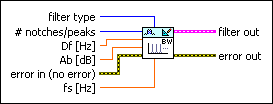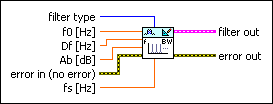DFD IIR Comb Design VI
Owning Palette: Special Filter Design VIs
Installed With: Digital Filter Design Toolkit
Creates an infinite impulse response (IIR) comb filter. You must manually select the polymorphic instance you want to use.
Use the pull-down menu to select an instance of this VI.
 Place on the block diagram Place on the block diagram |  Find on the Functions palette Find on the Functions palette |
DFD IIR Comb Design by N and Bandwidth

 | filter type specifies the type of IIR comb filter.
| ||||||||
 | # notches/peaks specifies the number of notches or peaks in the full frequency band from 0 to fs. The default is 10. | ||||||||
 | Df defines the full bandwidth at the level of –Ab. The default is 0.02.
Df represents  f. f.
| ||||||||
 | Ab specifies the attenuation that corresponds to the bandwidth. The default is 3.0103, which corresponds to 3 dB bandwidth, the commonly used bandwidth of a filter. | ||||||||
 | error in describes error conditions that occur before this VI or function runs.
The default is no error. If an error occurred before this VI or function runs, the VI or function passes the error in value to error out. This VI or function runs normally only if no error occurred before this VI or function runs. If an error occurs while this VI or function runs, it runs normally and sets its own error status in error out. Use the Simple Error Handler or General Error Handler VIs to display the description of the error code. Use error in and error out to check errors and to specify execution order by wiring error out from one node to error in of the next node.
| ||||||||
 | fs specifies the sampling frequency in hertz. The value must be greater than zero. The default is 1, which is the normalized sampling frequency. | ||||||||
 | filter out returns a new filter. | ||||||||
 | error out contains error information. If error in indicates that an error occurred before this VI or function ran, error out contains the same error information. Otherwise, it describes the error status that this VI or function produces.
Right-click the error out front panel indicator and select Explain Error from the shortcut menu for more information about the error.
|
DFD IIR Comb Design by f0 and Bandwidth

 | filter type specifies the type of IIR comb filter.
| ||||||||
 | f0 specifies the center frequency of the first nonzero notch or peak. The default is 0.1. The value of fs/f0 must be an integer for a Type I comb filter design. The value of fs/(f0*2) must be an integer for a Type II comb filter design. | ||||||||
 | Df defines the full bandwidth at the level of –Ab. The default is 0.02.
Df represents  f. f.
| ||||||||
 | Ab specifies the attenuation that corresponds to the bandwidth. The default is 3.0103, which corresponds to 3 dB bandwidth, the commonly used bandwidth of a filter. | ||||||||
 | error in describes error conditions that occur before this VI or function runs.
The default is no error. If an error occurred before this VI or function runs, the VI or function passes the error in value to error out. This VI or function runs normally only if no error occurred before this VI or function runs. If an error occurs while this VI or function runs, it runs normally and sets its own error status in error out. Use the Simple Error Handler or General Error Handler VIs to display the description of the error code. Use error in and error out to check errors and to specify execution order by wiring error out from one node to error in of the next node.
| ||||||||
 | fs specifies the sampling frequency in hertz. The value must be greater than zero. The default is 1, which is the normalized sampling frequency. | ||||||||
 | filter out returns a new filter. | ||||||||
 | error out contains error information. If error in indicates that an error occurred before this VI or function ran, error out contains the same error information. Otherwise, it describes the error status that this VI or function produces.
Right-click the error out front panel indicator and select Explain Error from the shortcut menu for more information about the error.
|
Examples
Refer to the following VIs for examples of using the DFD IIR Comb Design VI:
- IIR Comb Filter Design VI: labview\examples\Digital Filter Design\Floating-Point Filters\Conventional
- Noise Cancellation for ECG Signal by Notch Filter VI: labview\examples\Digital Filter Design\Floating-Point Filters\Conventional




